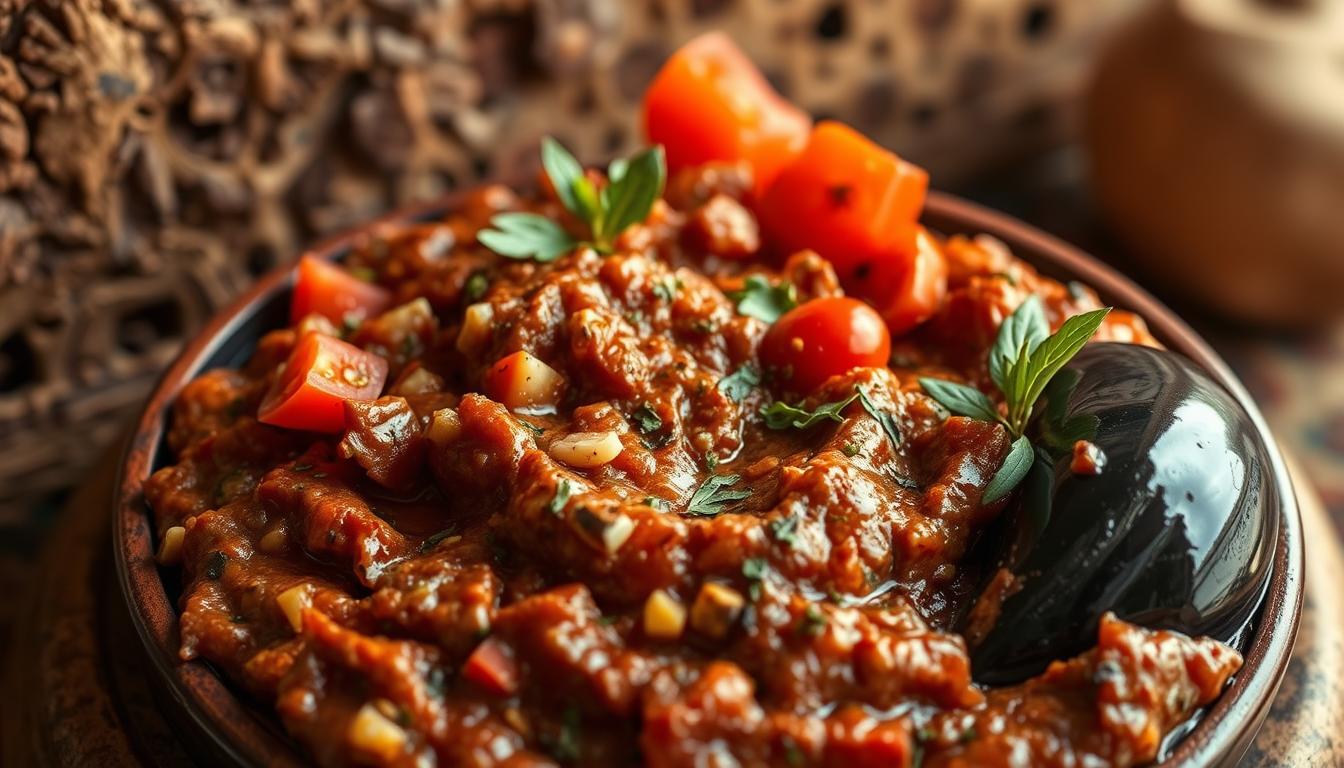Imagine walking through a lively Marrakech market. The smell of spices and roasted veggies fills the air. When I first tried zaalouk d’aubergines, a traditional Moroccan eggplant dip, it was a game-changer. It made me see appetizers in a whole new light.
This smoky aubergine appetizer is more than a recipe. It’s a dive into Moroccan cuisine’s heart. The roasted eggplant dip is a perfect mix of Mediterranean flavors and simple ingredients. It shows the beauty of cultural tradition in every bite.
Zaalouk, a favorite Moroccan eggplant salad, turns simple ingredients into a stunning spread. It takes your taste buds on a trip to North Africa. Whether you’re an experienced cook or just starting out, this charred eggplant spread is a must-try.
Key Takeaways
- Authentic Moroccan culinary tradition in one delicious dip
- Gluten-free and vegetarian-friendly recipe
- Rich in nutrients and incredibly flavorful
- Easy to prepare with simple ingredients
- Versatile dish for appetizers and side dishes
Introduction to Traditional Moroccan Zaalouk
Zaalouk is at the heart of vegetarian Moroccan cuisine. It’s a traditional starter that shows the beauty of North African cooking. This eggplant dish is a key example of Moroccan tapas, with its rich flavors and cultural depth.
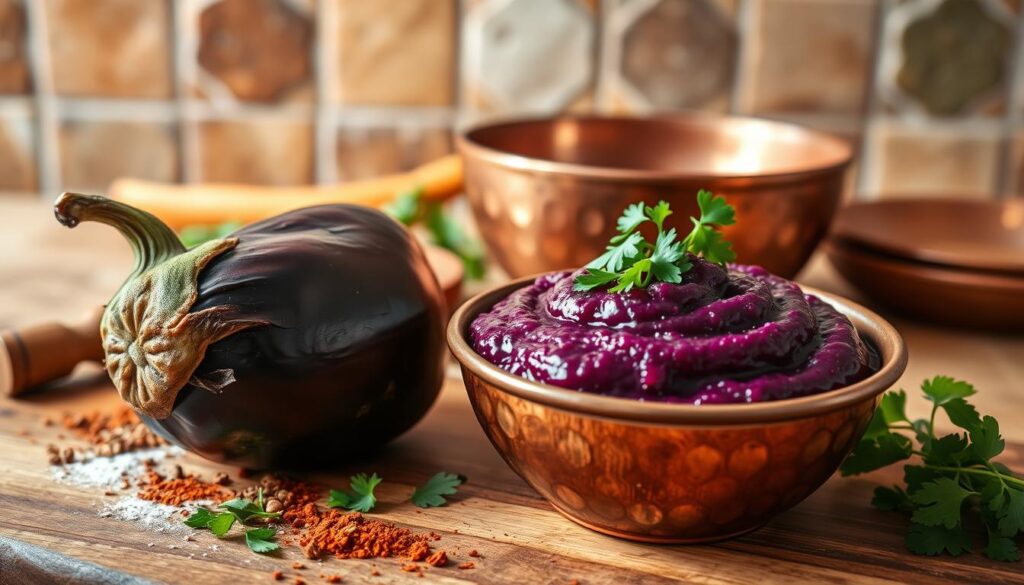
Origins and Cultural Significance
Zaalouk has deep roots in Moroccan cooking traditions. Every family adds their own twist to this eggplant dish. This creates a rich tapestry of flavors that show the diversity and creativity of Moroccan cooking.
“In Morocco, every kitchen tells a story through its zaalouk” – Moroccan Culinary Proverb
The Art of Moroccan Dips
Moroccan dips are more than just sides. They are works of art. Zaalouk is a perfect example, turning simple ingredients into a burst of flavors.
- Typically served at room temperature
- Combines roasted eggplants with aromatic spices
- Perfect as a spread or side dish
Role in Mediterranean Cuisine
In the Mediterranean, zaalouk is a standout dish. It’s versatile and nutritious. It’s loved by those who enjoy authentic, plant-based foods that honor tradition and modern tastes.
Essential Ingredients for Authentic Zaalouk
To make a real Moroccan eggplant dip, you need the right ingredients. These ingredients are key to making a delicious vegetarian appetizer. They turn simple items into a flavorful roasted eggplant spread.
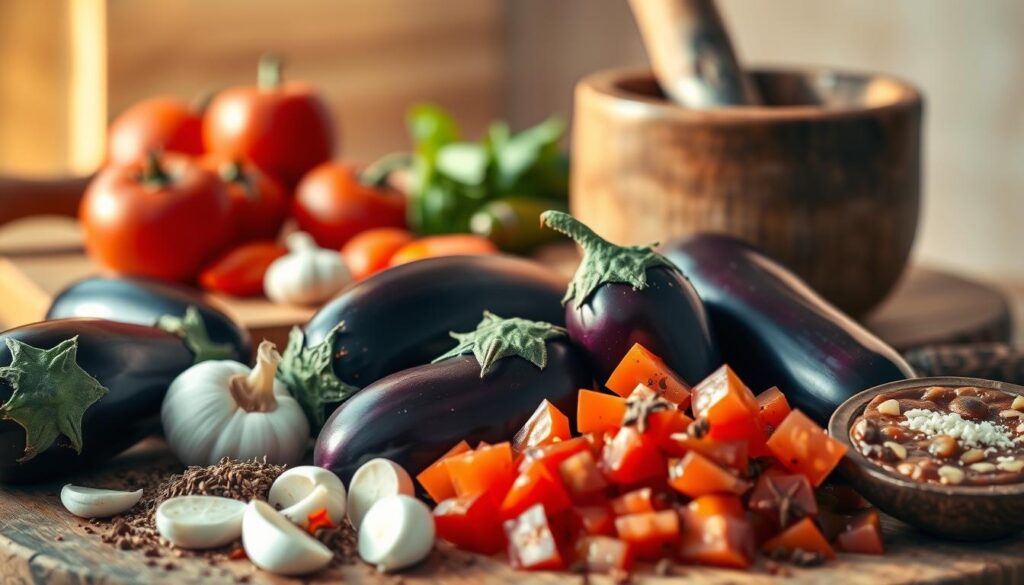
Let’s look at the main ingredients that make Zaalouk a true Moroccan dish:
- Fresh Vegetables
- 2 lbs eggplant (approximately 1 kg)
- 2 cups chopped tomatoes
- 3 fresh garlic cloves
- Herbs
- 4 Tbsp fresh cilantro
- Fresh parsley
- Spices
- 2 tsp smoked paprika
- 1 tsp ground cumin
- ½ tsp ground coriander
“The magic of Zaalouk lies in its simplicity and the harmonious blend of fresh ingredients.” – Moroccan Culinary Tradition
Choosing the right spices is very important. Paprika, cumin, and coriander give Zaalouk its unique taste. This mix of spices makes the dish truly special.
| Ingredient | Quantity | Purpose |
|---|---|---|
| Olive Oil | 2 Tbsp (roasting) | Enhances flavor, provides moisture |
| Sea Salt | 1 tsp | Balances and intensifies flavors |
| Lemon Juice | 1 Tbsp | Adds brightness and acidity |
Using top-quality, fresh ingredients makes a big difference. It turns a simple eggplant dip into a memorable dish. This dish celebrates the rich tastes of Moroccan cuisine.
Understanding Eggplant Selection and Preparation
Choosing the right eggplants is key for a great north African recipe like zaalouk. The dish’s rich, smoky flavors depend on quality ingredients.
Choosing the Perfect Eggplants
Here are some tips for picking the best eggplant for your tomato-based spread:
- Select globe eggplants with tight, smooth skin
- Avoid eggplants with blemishes or soft spots
- Choose medium-sized eggplants to minimize seed content
- Look for firm, heavy eggplants with a deep purple color
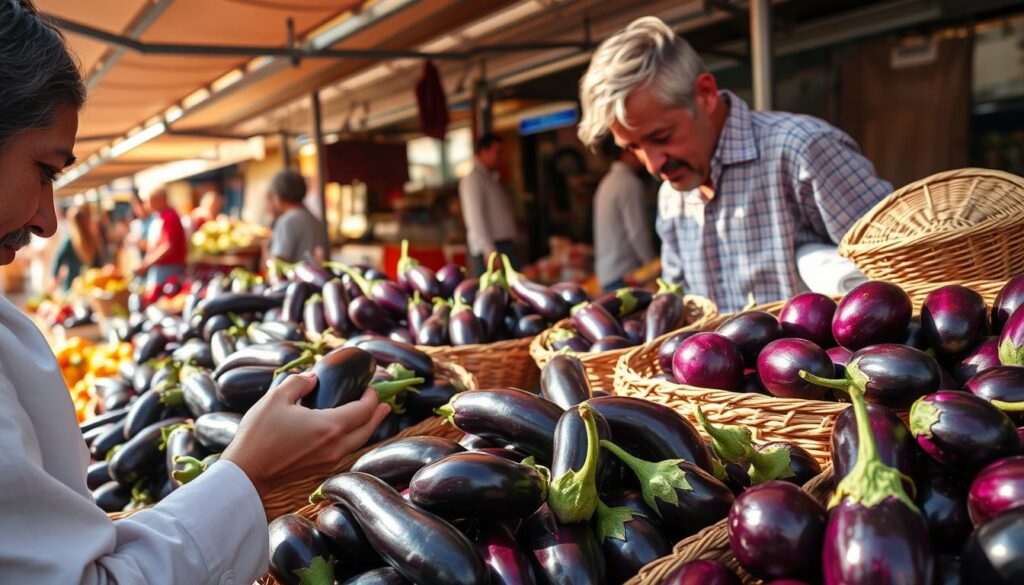
Preparation Techniques
Preparing eggplants for zaalouk needs careful attention. You want to make a luxurious eggplant caviar that captures Moroccan essence.
- Wash the eggplant thoroughly
- Trim the ends
- Optional: Remove skin for smoother texture
- Cut into uniform pieces for even cooking
Pre-cooking Methods
Pre-cooking techniques can greatly affect your zaalouk’s flavor:
- Roasting: Creates deep, smoky flavors (recommended at 400°F for 20-25 minutes)
- Grilling: Adds charred notes to the dish
- Steaming: Provides a lighter, more delicate texture
- Boiling: Quick method for those short on time
“The secret to great zaalouk lies in how you prepare your eggplants.” – Moroccan Culinary Tradition
Pro tip: Roasting eggplants skin-side up under the broiler helps develop those characteristic smoky flavors. Aim for about 20-25 minutes of cooking until the skin becomes charred and the flesh is tender.
The Art of Roasting Eggplants for Maximum Flavor
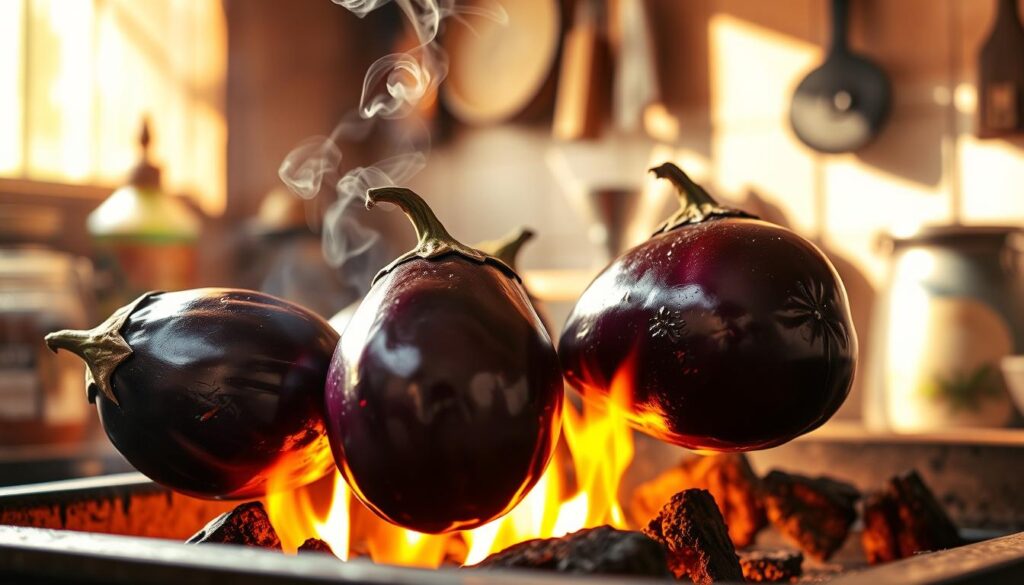
Roasting eggplants is a secret to making a smoky eggplant spread for your vegetarian Moroccan dishes. It turns ordinary eggplants into a rich, flavorful mashed eggplant appetizer. This is what makes authentic Moroccan eggplant dishes stand out.
To get the best roast, follow these steps:
- Choose medium-sized, firm eggplants with smooth, glossy skin
- Preheat your oven to 180°C (350°F) for optimal roasting
- Pierce the eggplant skin to prevent it from bursting
- Roast for 20-25 minutes, turning occasionally for even charring
Pro tip: Consider inserting whole garlic cloves into small incisions in the eggplant. This technique infuses extra depth into your eggplant salad recipes, creating a more complex flavor profile.
“The magic of Moroccan cuisine lies in transforming simple ingredients through careful preparation” – Traditional Moroccan Chef
When roasting, watch for visual and textural signs. The skin should be charred and wrinkled, and the inside soft and creamy. This usually takes 45 to 75 minutes, depending on how tender you want it.
Different roasting methods give different results:
- Oven roasting: Most consistent and controlled method
- Open flame grilling: Provides intense smoky flavor
- Broiling: Quick alternative for smaller kitchens
Remember, patience is key to getting that smoky flavor that’s a hallmark of traditional Moroccan zaalouk.
Zaalouk d’Aubergines Moroccan Recipes: Step-by-Step Guide
Making an authentic Moroccan eggplant dip needs care and love. Zaalouk is a favorite in North Africa, mixing rich tastes with old cooking ways.
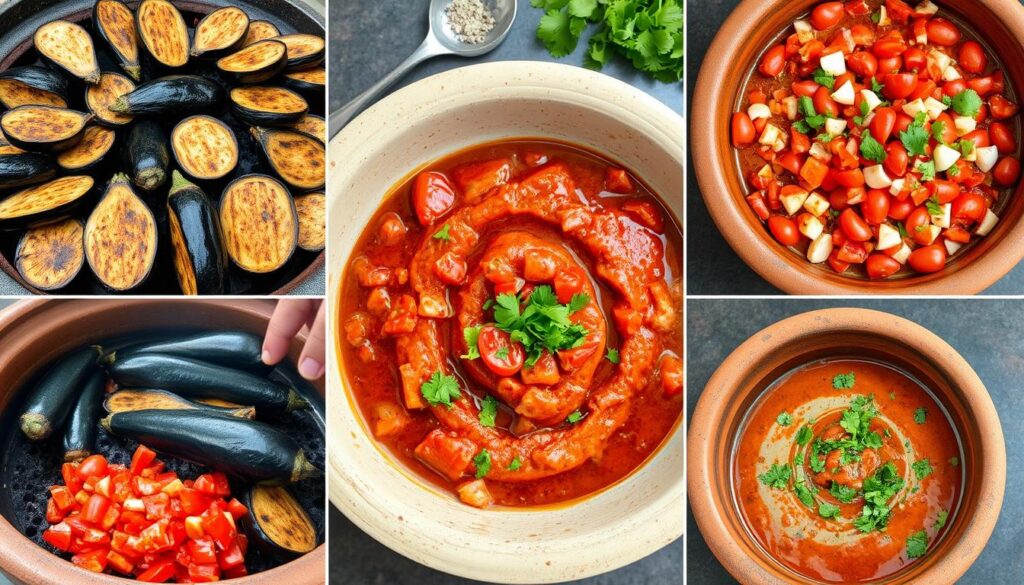
To make this classic dish, follow some important steps. These steps turn simple ingredients into a special dish. Learning how to make zaalouk starts with knowing how to prepare it.
Traditional Cooking Process
First, get your ingredients ready for this smoked paprika recipe. You’ll need:
- 1.5 lbs fresh eggplants
- 1 lb ripe tomatoes
- 4 tablespoons olive oil
- 4 garlic cloves
Seasoning and Spice Balance
The secret of zaalouk is its garlic and cumin flavors. Your chermoula spice mix will make the dish even better. Add these spices:
- 1 teaspoon cumin seeds
- 1 teaspoon caraway seeds
- 2 teaspoons paprika
- 2 tablespoons fresh lemon juice
Roast eggplants at 400˚F for 35-45 minutes until they’re soft and slightly charred. Then, chop them and mix with tomatoes in a skillet. Cook for 15-20 minutes, stirring often, until it’s smooth and creamy.
“The perfect zaalouk is a delicate balance of smoky eggplant, bright tomatoes, and aromatic spices.” – Moroccan Cooking Tradition
Your dish should be creamy, full of flavor, and ready to serve as a tasty dip or side. Store leftovers in the fridge for 4-5 days or freeze for later.
Mastering the Perfect Texture and Consistency
Making the perfect texture for your traditional moroccan zaalouk is an art. It’s about finding the right balance between taste and technique. This roasted eggplant salad can be anything from a chunky appetizer to a smooth purée.
When making your mashed eggplant dish, keep these texture tips in mind:
- Use a fork for a rustic, chunky texture
- Employ a potato masher for medium consistency
- Utilize a food processor for ultra-smooth purée
The secret to the perfect zaalouk texture is in the cooking and mashing. Your goal is to turn roasted eggplants into a delicious spread that captures the essence of Moroccan cuisine.
“Texture is the silent language of culinary art” – Moroccan Cooking Proverb
Try different cooking times and mashing methods to find your perfect texture. Some like a chunky moroccan eggplant appetizer. Others prefer a smooth purée that spreads easily.
Pro tip: Let your eggplants cool a bit before mashing. This helps control the texture and prevents over-processing. The ideal consistency is neither too dry nor too wet. It should be a perfect blend that tells a tasty story on your plate.
Traditional Spices and Aromatics
Moroccan cuisine is known for its bold flavors, thanks to spices. These spices are key in making dishes like roasted eggplant zaalouk. They turn simple vegetables into amazing meals.
Essential Moroccan Spice Combinations
For an authentic eggplant salad recipe, certain spices are vital. The main spices are:
- Cumin: Adds earthy warmth and depth
- Smoked Paprika: Provides rich, smoky undertones
- Cayenne Pepper: Introduces subtle heat
Fresh Herbs and Their Impact
Fresh herbs like cilantro and parsley make zaalouk special. They’re not just for looks but add a lot of flavor.
“Spices are the soul of Moroccan cooking, transforming ordinary ingredients into extraordinary experiences.” – Moroccan Culinary Tradition
These spices blend together beautifully, showing off Morocco’s rich food culture. About 50% of Moroccan homes use these spices every day. They’re not just for flavor; they’re a way to share culture.
Health Benefits and Nutritional Value
Zaalouk is a healthy Moroccan appetizer that meets many dietary needs. It’s not just tasty but also full of nutrients. As a smoky eggplant salad, it brings many health benefits to those who love healthy food.
Zaalouk is great for many diets because of its nutritional profile. Here are some key health benefits:
- Completely vegan-friendly
- Gluten-free recipe
- Low-carbohydrate option
- No dairy or soy ingredients
- Rich in dietary fiber
Eggplants, the main ingredient, are very nutritious. They have very few calories, about 20 per 100 grams, and 3 grams of fiber.
“Nutrition isn’t about perfection, it’s about balance and making smart, delicious choices” – Anonymous Nutritionist
| Nutrient | Amount per Serving | % Daily Value |
|---|---|---|
| Calories | 152 kcal | 7.6% |
| Total Fat | 14 g | 22% |
| Dietary Fiber | 4 g | 17% |
| Protein | 1 g | 2% |
| Vitamin C | 6 mg | 7% |
Olive oil in zaalouk adds heart-healthy fats. Tomatoes bring lycopene, a strong antioxidant. Choosing this dish means you’re boosting your health with every bite.
Serving Suggestions and Accompaniments
Zaalouk is a tasty vegetarian dish from Morocco. It’s perfect for adding flavor to any meal. This dish turns simple ingredients into a feast for the senses.
Traditional Serving Methods
In traditional settings, zaalouk is a star of mezze spreads. Moroccan families love to serve it with:
- Warm, freshly baked khobz (Moroccan bread)
- Grilled flatbreads
- As part of a larger salad assortment
Modern Pairing Options
Zaalouk is great for modern recipes too. It can be a side dish for many meals.
| Pairing Category | Recommended Options |
|---|---|
| Protein Companions | Grilled chicken, lamb kebabs, fish |
| Vegetarian Matches | Roasted vegetables, quinoa bowls |
| Garnish Options | Fresh cilantro, chili peppers, olive oil drizzle |
Serve zaalouk slightly warm or at room temperature. A light drizzle of extra virgin olive oil and fresh herbs make it look great.
“Zaalouk is more than a dip—it’s a culinary journey through Moroccan flavors.” – Moroccan Cuisine Experts
Storage Tips and Make-Ahead Options
Preparing your cumin spiced eggplant puree ahead of time can be a game-changer for home cooks. Zaalouk, the beloved Moroccan aubergine spread, offers remarkable flexibility when it comes to storage and preparation.
Refrigeration Guidelines
Your charred eggplant salad can be safely stored in an airtight container for 4-5 days. Always use clean utensils when handling to prevent bacterial contamination.
- Store in glass or ceramic containers
- Keep refrigerated at 40°F or below
- Seal tightly to preserve moisture
Freezing Your Zaalouk
For longer-term storage of your charred eggplant recipes, freezing is an excellent option. Your zaalouk can remain fresh for up to 3 months when properly prepared.
| Storage Method | Duration | Recommended Container |
|---|---|---|
| Refrigeration | 4-5 days | Airtight glass container |
| Freezing | 2-3 months | Freezer-safe plastic container |
Reheating and Reviving
When ready to enjoy your stored zaalouk, follow these simple steps:
- Thaw frozen zaalouk in the refrigerator overnight
- Gently reheat in a pan over low heat
- Adjust consistency by adding a splash of water if needed
- Taste and refresh seasonings
*”The beauty of zaalouk lies in its ability to develop deeper flavors over time.”*
By mastering these storage techniques, you’ll always have a delicious Moroccan appetizer ready to impress your guests or enjoy as a quick, flavorful snack.
Regional Variations and Modern Adaptations
Zaalouk, the beloved smoky eggplant puree, shows incredible culinary diversity across Morocco and beyond. Each region adds its own twist to this classic dish. This turns the traditional recipe into a canvas of local flavors and ingredients.
The variations of this smoky eggplant appetizer reflect the rich cultural tapestry of Moroccan cuisine. In coastal regions, chefs might add local seafood. Urban restaurants experiment with fusion techniques that elevate the charred eggplant puree.
- Coastal Adaptations: Seafood-infused zaalouk with fresh marine flavors
- Urban Innovations: Fusion versions incorporating avocado or international spices
- Regional Spice Blends: Unique local spice combinations that distinguish each version
Modern interpretations have embraced global culinary trends. About 60% of urban restaurants create innovative zaalouk dishes. The popularity of this eggplant delicacy has grown by 25% in international restaurants, showing its adaptability and universal appeal.
“Zaalouk is not just a dish, it’s a culinary journey through Morocco’s diverse regions and flavors.” – Moroccan Food Experts
Whether you’re enjoying a traditional preparation or a contemporary twist, zaalouk continues to captivate food lovers. It’s versatile and has a rich taste profile. From street food vendors to high-end restaurants, this eggplant delicacy remains a cherished part of Moroccan culinary heritage.
Common Mistakes to Avoid When Making Zaalouk
Making the perfect Moroccan eggplant dip needs careful attention. When you’re making this vegetarian appetizer, some common mistakes can affect its taste and texture. Knowing these mistakes helps you make a true Middle Eastern dish that shows off Maghreb cuisine’s spirit.
Texture Challenges in Moroccan Cuisine
Getting the right texture is key for a great eggplant dip. Many people find it hard to get the semi-chunky texture that’s typical of zaalouk. If you overcook it, it becomes mushy. If you undercook it, the vegetables stay too hard.
Try to cook your eggplant and tomatoes until they’re soft but not too soft. They should keep some of their shape.
Seasoning Balance Expertise
The secret to a top-notch zaalouk is in the seasoning. Be careful with acidic ingredients like lemon juice, as they can overpower the flavors. If your zaalouk tastes too sharp, a bit of honey or sugar can help balance it out.
Start with 3/4 teaspoon of salt and adjust to taste. For those who like a bit of heat, add 1/4 to 1/2 teaspoon of chili flakes. This will give your classic Moroccan recipe an extra kick.

